- 19/10/2006
- 8
- 68
- 48
Este documento te guiará en el proceso de preparación de grano de cereales para el cultivo de setas. El grano se podrá utilizar directamente para producir setas o para inocular otros sustratos más complejos.
There are 2 ways of preparing the grain, either by measuring grain and water, combining them in a jar and pressure cooking it, or first simmering the grain in order to achieve the proper water content, and then pressure cooking it. Both methods work similarly well.
Receta básica de centeno para tarros de 1/2 l
* 100g centeno
* 110g agua
* una pizca de yeso
Si el centeno se va a emplear para inocular otros sustratos, habrá que utilizar un poco menos de agua (yo utilizo 105 g en este caso).
Basic millet or birdseed recipe for 1 pint jar
* 100g mijo
* 60-70g agua
* una pizca de yeso
Grains
centeno
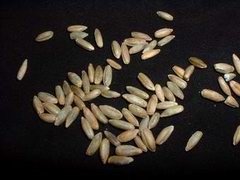
Birdseed
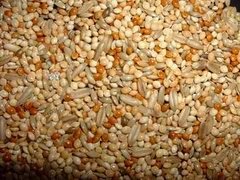
mijo
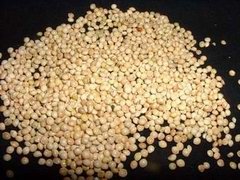
Preparation
Pon la cantidad indicada de grano y agua en un tarro (si quieres puedes añadir una pizca de yeso opcional que ayudará para que el grano no se apelmace). Cierra bien el tarro con la tapa que habrás modificado previamente para poner un filtro de polyfill y esteriliza en olla a presión durante 1 hora a 15 psi.
La capacidad de absorción del grano puede variar dependiendo de su calidad, así como del tipo y tamaño de olla a presión utilizada.
Es conveniente preparar una muestra de tarros cuando adquirimos un tipo o marca de grano por primera vez. Se trata de saber cual es la cantidad de agua óptima para el tipo de grano comprado. Prepara 5 tarros con la cantidad de grano descrita más arriba y 100, 105, 110, 115 y 120 gr de agua respectivamente, podrás hacerte una idea de que cantidad de agua da los mejores resultados y actuar en consecuencia..
En cuanto la presión de la olla disminuya y se pueda abrir sin peligro, saca los tarros aún calientes y menealos con fuerza para mezclar bien los granos más húmedos con los más secos. Utiliza un paño de cocina si queman demasiado.
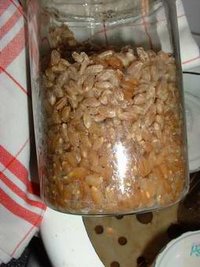
Si le das la vuelta a un tarro verás como los granos secos se desprenden de los húmedos sin esfuerzo.
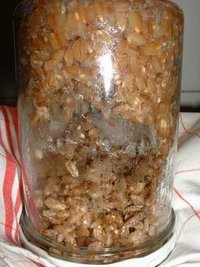
Todos los granos deberían tener un aspecto húmedo después de haberlos meneado, condición que cambiará pasados unos días tras la inoculación.
Una vez meneados los tarros, vuelve a meterlos en la olla y deja reposar hasta que se enfríen por completo.
En el caso de la foto y una vez colonizado el grano por el micelio, éste será utilizado para producir directamente setas y no para inocular sustratos compostados más complejos
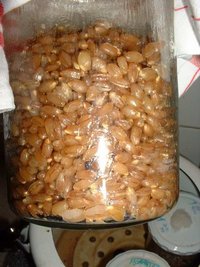
El grano que se vaya a utilizar para inocular sustratos compostados tendrá que tener un aspecto más seco y con menos granos reventados. En la foto, el centeno fue cocido en olla a presión hace 48 horas y la proporción de centeno/agua utilizada de 100g/105g respectivamente.
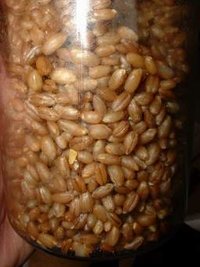
Preparing grain by simmering
Alternatively you can prepare the grain by simmering in order to give it the correct water content. The procedure step by step:
1. Weight out the amount of grain needed (~100g per pint jar).
2. Bring double the weight of water to a boil and put the grain in it. Start timing.
3. Reduce the heat so the water is barely moving. Stir the grain occasionally with a fork.
4. After ~30 minutes (for millet or birdseed) or after ~40 minutes (for rye) pour the now swollen grain through a strainer and let is drain for ~20 minutes. The exact simmer times depend on your grain, the size of the pot and other factors. For the start, follow the above times as closely as possible and then, if you see that the water content is not perfect, vary the times a bit.
5. Fill the of grain in the jars, screw the lid fitted with a polyfill filter tight and pressure cook for 1 hour at 15 psi. If you don't know how to use a pressure cooker, check out this document about the correct pressure cooker use.
6. After the pressure has settled, take the still very hot jars from the cooker (using a towel to protect your hands) and shake them well to mix the wetter and drier kernels.
Cocción de centeno antes de la esterilización - RESULTADOS DEL TEST
(publicado originalmente en Shroomery)
Para comprobar la capacidad de absorción del centeno, decidí hacer una prueba.
Pesé 3 veces 100 gr. de centeno en grano.
Experimento:
1. 100 g de centeno fueron secados en un horno a 140°C durante 90 minutos.
2. 100 g de centeno fueron cocidos a fuego lento en 500 ml de agua durante 30 minutos.
3. 100 g de centeno fueron cocidos a fuego lento en 500 ml de agua durante 40 minutos.
Resultados:
1. Tras los 90 minutos de secado en el horno, los 100 g de centeno pesaron 88 g --> 12% de humedad contenida en el centeno.
2. Después de aclarar bajo agua durante 20 minutos, el grano pesó 190 g, sin granos reventados --> (12g+90g)/190g = 54% de humedad contenida en el centeno.
3. Después de aclarar bajo agua durante 20 minutos, el grano pesó 200 g, con algunos granos reventados. Creo que éste sería el límite ya que demasiados granos explotados no son beneficiosos --> (12g+100g)/200g = 56% de humedad contenida en el centeno.
Conclusión:
Cocer el grano antes de esterilizarlo es una opción viable. Esta prueba demuestra que con la lenta cocción del grano durante 40 minutos se consigue, más o menos, el mismo propósito que cuando se mezclan todos los ingredientes y se esterilizan directamente (100g de grano y 110g agua).







There are 2 ways of preparing the grain, either by measuring grain and water, combining them in a jar and pressure cooking it, or first simmering the grain in order to achieve the proper water content, and then pressure cooking it. Both methods work similarly well.
Receta básica de centeno para tarros de 1/2 l
* 100g centeno
* 110g agua
* una pizca de yeso
Si el centeno se va a emplear para inocular otros sustratos, habrá que utilizar un poco menos de agua (yo utilizo 105 g en este caso).
Basic millet or birdseed recipe for 1 pint jar
* 100g mijo
* 60-70g agua
* una pizca de yeso
Grains
centeno

Birdseed

mijo

Preparation
Pon la cantidad indicada de grano y agua en un tarro (si quieres puedes añadir una pizca de yeso opcional que ayudará para que el grano no se apelmace). Cierra bien el tarro con la tapa que habrás modificado previamente para poner un filtro de polyfill y esteriliza en olla a presión durante 1 hora a 15 psi.
La capacidad de absorción del grano puede variar dependiendo de su calidad, así como del tipo y tamaño de olla a presión utilizada.
Es conveniente preparar una muestra de tarros cuando adquirimos un tipo o marca de grano por primera vez. Se trata de saber cual es la cantidad de agua óptima para el tipo de grano comprado. Prepara 5 tarros con la cantidad de grano descrita más arriba y 100, 105, 110, 115 y 120 gr de agua respectivamente, podrás hacerte una idea de que cantidad de agua da los mejores resultados y actuar en consecuencia..
En cuanto la presión de la olla disminuya y se pueda abrir sin peligro, saca los tarros aún calientes y menealos con fuerza para mezclar bien los granos más húmedos con los más secos. Utiliza un paño de cocina si queman demasiado.

Si le das la vuelta a un tarro verás como los granos secos se desprenden de los húmedos sin esfuerzo.

Todos los granos deberían tener un aspecto húmedo después de haberlos meneado, condición que cambiará pasados unos días tras la inoculación.
Una vez meneados los tarros, vuelve a meterlos en la olla y deja reposar hasta que se enfríen por completo.
En el caso de la foto y una vez colonizado el grano por el micelio, éste será utilizado para producir directamente setas y no para inocular sustratos compostados más complejos

El grano que se vaya a utilizar para inocular sustratos compostados tendrá que tener un aspecto más seco y con menos granos reventados. En la foto, el centeno fue cocido en olla a presión hace 48 horas y la proporción de centeno/agua utilizada de 100g/105g respectivamente.

Preparing grain by simmering
Alternatively you can prepare the grain by simmering in order to give it the correct water content. The procedure step by step:
1. Weight out the amount of grain needed (~100g per pint jar).
2. Bring double the weight of water to a boil and put the grain in it. Start timing.
3. Reduce the heat so the water is barely moving. Stir the grain occasionally with a fork.
4. After ~30 minutes (for millet or birdseed) or after ~40 minutes (for rye) pour the now swollen grain through a strainer and let is drain for ~20 minutes. The exact simmer times depend on your grain, the size of the pot and other factors. For the start, follow the above times as closely as possible and then, if you see that the water content is not perfect, vary the times a bit.
5. Fill the of grain in the jars, screw the lid fitted with a polyfill filter tight and pressure cook for 1 hour at 15 psi. If you don't know how to use a pressure cooker, check out this document about the correct pressure cooker use.
6. After the pressure has settled, take the still very hot jars from the cooker (using a towel to protect your hands) and shake them well to mix the wetter and drier kernels.
Cocción de centeno antes de la esterilización - RESULTADOS DEL TEST
(publicado originalmente en Shroomery)
Para comprobar la capacidad de absorción del centeno, decidí hacer una prueba.
Pesé 3 veces 100 gr. de centeno en grano.
Experimento:
1. 100 g de centeno fueron secados en un horno a 140°C durante 90 minutos.
2. 100 g de centeno fueron cocidos a fuego lento en 500 ml de agua durante 30 minutos.
3. 100 g de centeno fueron cocidos a fuego lento en 500 ml de agua durante 40 minutos.
Resultados:
1. Tras los 90 minutos de secado en el horno, los 100 g de centeno pesaron 88 g --> 12% de humedad contenida en el centeno.
2. Después de aclarar bajo agua durante 20 minutos, el grano pesó 190 g, sin granos reventados --> (12g+90g)/190g = 54% de humedad contenida en el centeno.
3. Después de aclarar bajo agua durante 20 minutos, el grano pesó 200 g, con algunos granos reventados. Creo que éste sería el límite ya que demasiados granos explotados no son beneficiosos --> (12g+100g)/200g = 56% de humedad contenida en el centeno.
Conclusión:
Cocer el grano antes de esterilizarlo es una opción viable. Esta prueba demuestra que con la lenta cocción del grano durante 40 minutos se consigue, más o menos, el mismo propósito que cuando se mezclan todos los ingredientes y se esterilizan directamente (100g de grano y 110g agua).







